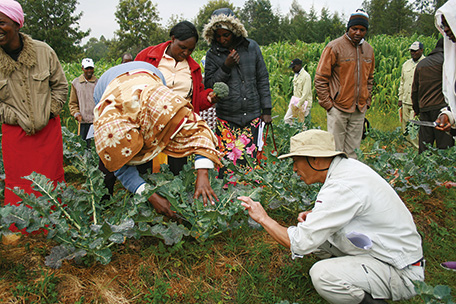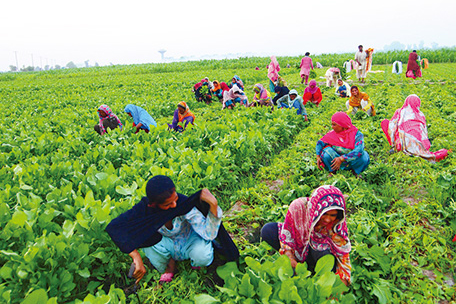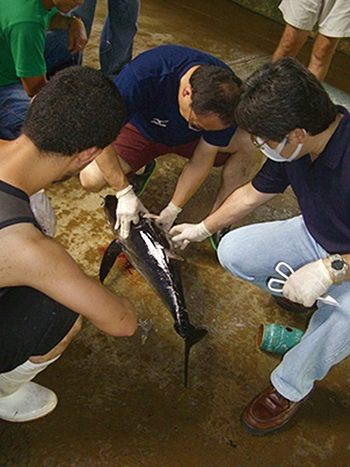(3) Promotion of Agriculture, Forestry and Fisheries, and Development of Food Value Chains
The population of undernourished people in the world still remains large, and the world’s population growth is anticipated to further increase food demand. Under these circumstances, the 2030 Agenda for Sustainable Development sets Goal 1 as “End poverty in all its forms everywhere” and Goal 2 as “End hunger, achieve food security and improved nutrition and promote sustainable agriculture.” To achieve these goals and realize quality growth in developing countries, efforts to develop agriculture are an urgent challenge. In addition, three out of four poor people in developing countries live in rural areas. Because the majority of these individuals rely on farming for a living, efforts to develop agriculture and rural communities are important.
< Japan’s Efforts >
Based on the Development Cooperation Charter approved by the Cabinet in February 2015, Japan proactively addresses global food security, giving priority to cooperation that develops agriculture, forestry and fisheries, including the development of food value chains, in order to achieve “quality growth” in developing countries and poverty eradication through such growth. In the short term, Japan provides food assistance to developing countries to avert food shortages. In the medium- to long-term, Japan aims to help increase and improve agricultural production and productivity in developing countries in order to prevent and eliminate the causes of food-related problems including hunger.
Specifically, Japan uses its knowledge and experience to strengthen agricultural research and technology development, along with capacity-building to disseminate this technology in a way that is suited to the cultivation environment, to promote the sustainable use of fishery resources, to strengthen organizations of farmers, to assist policymaking, as well as to improve infrastructures such as irrigation facilities, farm roads, and fishing ports. Through these efforts, Japan extends various supports, from production, processing, distribution, to sales phases.
In Africa, Japan also supports the research of NERICA* (New Rice for Africa) and the spread of its production techniques, and provides support for increasing rice production based on the Comprehensive Africa Agriculture Development Programme (CAADP), and for the introduction of a market-based agricultural promotion (SHEP: Smallholder Horticulture Empowerment Project) approach,* among others. In addition, in order to assist reducing post-harvest loss,* revitalizing the food industry, and increasing rural incomes, Japan places priority on assistance for developing “food value chains.” This refers to creating a chain of added values around food by enhancing the added value of agricultural, forestry and fishery products at each phase of the process from production to manufacturing, processing, distribution, and consumption, and linking these added values.
In June 2014, the Ministry of Agriculture, Forestry and Fisheries (MAFF) formulated the Global Food Value Chain Strategy, after conducting reviews in collaboration with academia, private companies, relevant ministries and agencies, and others. The Strategy lays out a basic strategy and region-specific strategies for developing food value chains in developing countries and elsewhere. In accordance with this Strategy, bilateral dialogues were held through public-private cooperation in countries, such as Viet Nam, Myanmar, and Brazil, to promote the development of food value chains by linking development cooperation and Japanese private sector investment. In August 2015, at the Second High-Level Meeting of the Japan-Viet Nam Agricultural Cooperation Dialogue, the two sides approved a medium- to long-term vision that outlines detailed action plans for developing food value chains in Viet Nam through partnerships between the public and private sectors of Japan and Viet Nam.
With respect to food security, at the outreach session on food security at the G8 L’Aquila Summit (Italy) in July 2009, Japan pledged at least $3 billion over three years in 2010-2012 for agricultural development including infrastructure, and provided approximately $4.2 billion (commitment basis) by the end of 2012. Additionally, the rapid increase of agricultural investment in developing countries had become an international issue since some of the investments were reported as “land grabbing” by some media outlets. For this reason, Japan proposed the concept of “Responsible Agricultural Investment (RAI)*” at the L’Aquila Summit, which has since gained support at international fora such as the G7/8, G20, and APEC. Furthermore, based on the RAI concept, the Principles for Responsible Investment in Agriculture and Food Systems were discussed at the Committee on World Food Security (CFS), whose Secretariat is comprised of the Food and Agriculture Organization of the United Nations (FAO), the International Fund for Agricultural Development (IFAD), and the World Food Programme (WFP), and were adopted at the CFS 41st Session in October 2014.
As to the New Alliance for Food Security and Nutrition,* which was established at the G8 Camp David Summit (the United States) in May 2012, its progress report was released and new African partner countries were announced at an event held in conjunction with the G8 Lough Erne Summit (the United Kingdom) in June 2013. Under the framework of the New Alliance, the relevant international organizations are implementing the “Forward-looking research and analysis programme for responsible agricultural investment” with financial support from Japan.
At the G7 Schloss Elmau Summit (Germany) in June 2015, the Broader Food Security and Nutrition Development Approach was unveiled, which aims to lift 500 million people in developing countries out of hunger and malnutrition by 2030.
Furthermore, Japan has promoted efforts to assist the Agricultural Market Information System (AMIS)* in the G20, which aims to enhance agricultural market transparency. Further, Japan provides assistance in the agricultural sector through the FAO, IFAD, the Consultative Group on International Agricultural Research (CGIAR), WFP, and other international organizations.
Japan underlines the importance of agriculture as an industry that plays a pivotal role in ensuring food security, reducing poverty, and stimulating economic growth throughout Africa, and contributes to the development of agriculture in Africa.
At the Fifth Tokyo International Conference on African Development (TICAD V) held in June 2013, Japan announced that it would continue its assistance for the Coalition for African Rice Development (CARD)* launched at TICAD IV in 2008, and that as an assistance measure to promote market-based agriculture, it would provide assistance for human resources development of 1,000 technical advisers, develop organizations for 50,000 smallholder farmers, and dispatch cooperation experts, as well as promote the SHEP approach (to be rolled out in 10 countries), among other measures.
At the Japan-African Regional Economic Communities (RECs) Summit Roundtable held in New York in September 2013, Japan discussed the theme of agricultural development. Agriculture was on the agenda at the First TICAD V Ministerial Meeting held in Cameroon in May 2014, reflecting also the African Union’s (AU) identification of 2014 as the Year of Agriculture and Food Security in Africa. At the meeting, Japan reported that it was steadily implementing the TICAD V support measures, explaining that rice production in Sub-Saharan Africa increased from 14 million tons to 20.7 million tons as of 2012 because of Japan’s CARD initiative, and that the incomes of smallholder farmers doubled in three years from 2006 in Kenya, thanks to the introduction of the SHEP approach, to be commenced in that country. African countries expressed appreciation for these efforts.
In June 2015, a side event regarding agricultural development through the TICAD process was held on the margins of the 39th Session of the FAO Conference in Rome. The event was attended by approximately 200 people from 43 African countries, other countries, and international organizations. Discussions took place on the importance of developing food value chains that take smallholder farmers into consideration, as well as on specific case studies from different countries. It was confirmed that their outcomes would be used as reference for the TICAD process.

A Japan Overseas Cooperation Volunteer (rural community development officer), Mr. Hikaru Nagase harvests broccoli together with local Kenyan farmers. (Photo: Miki Sembokuya / JICA)

Women engage in agricultural work in the Layyah District in Central Pakistan. (Photo: Satsuki Arai / JICA)
- *NERICA
- NERICA (New Rice for Africa) is a general term for rice developed in 1994 by the Africa Rice Center (formerly West Africa Rice Development Association [WARDA]) through hybridization of high-yield Asian rice with African rice, which is resistant to weeds, diseases and insect pests. Japan has also contributed to developing a variety of new types that are suited to the natural conditions of each region in Africa. The characteristics of the rice include (i) a higher yield, (ii) a shorter growth period, (iii) higher resistance to dryness (drought), and (iv) higher resistance to diseases and insect pests than conventional rice. Since 1997, Japan has partnered with international organizations and NGOs to provide support for research and development related to new types of NERICA, test cultivation, and increased production and popularization of seeds. In addition, Japan has dispatched agricultural experts and JOCVs, and has accepted trainees from Africa for training in Japan.
- *Market-based agricultural promotion (SHEP*) approach for smallholder farmers
- The SHEP approach refers to an effort to assist smallholder farmers to enhance their agricultural organizations through training and research on local markets, and to provide guidance on cultivation techniques and development of agricultural roads while taking account of gender, in order to help them improve their capacities to manage their agricultural businesses in accordance with the market.
*SHEP: Smallholder Horticulture Empowerment Project - *Post-harvest loss
- Post-harvest loss refers to harvested food that is discarded, because it is unable to fulfill its originally intended purpose (for use as food, etc.). This can be caused by improper harvest timing, and overexposure to rain or dryness, extremely high or low temperatures, germ contamination, or any other physical damage that reduces the value of the products due primarily to a lack of adequate storage facilities.
- *Responsible Agricultural Investment
- Responsible Agricultural Investment refers to an initiative proposed by Japan at the G8 L’Aquila Summit in response to unintentional negative impacts resulting from large-scale agricultural investment (acquisition of farmland with foreign capital) in developing countries in the face of spikes in international food prices. In addition to mitigating the negative impacts of agricultural investment, it aims to promote agricultural development in the host country as well as harmonize and maximize the benefits enjoyed by that country’s government, local people, and investors.
- *New Alliance for Food Security and Nutrition
- The New Alliance for Food Security and Nutrition refers to an initiative that was launched at the Camp David Summit (the United States) in 2012 with the aim of achieving sustainable and inclusive agricultural growth and lifting 50 million people out of poverty in Sub-Saharan Africa over the next 10 years, with the cooperation of donor countries, African countries, and the private sector. Under the initiative, the Country Cooperation Framework was formulated for the African partner countries, which includes financial commitments from donors, specific policy actions by the governments of partner countries, and private-sector investment intents. Ongoing efforts are being made with the cooperation framework that was formulated for ten countries by May 2014, namely, Benin, Burkina Faso, Côte d’Ivoire, Ethiopia, Ghana, Malawi, Mozambique, Nigeria, Senegal, and Tanzania.
- *Agricultural Market Information System (AMIS)
- AMIS was launched as a countermeasure against food price volatility by the G20 in 2011. It allows each of the G20 members, the main exporting and importing countries, companies, and international organizations to share agricultural and food market information (production output, price, etc.) in a timely, precise, and transparent manner. Japan has supported the efforts of ASEAN countries aimed at improving the accuracy of ASEAN agricultural and statistical information used as AMIS data.
- *Coalition for African Rice Development (CARD)
- CARD is a consultative group composed of donor countries, African regional organizations, and international organizations partnered with rice-producing countries in Africa that are interested in rice production and development. The CARD Initiative was announced at TICAD IV in 2008. Japan plans to train 50,000 agricultural advisors in relation to doubling rice production.
Panama
Comparative Studies of the Reproductive Biology and Early Life History of Two Tuna Species for the Sustainable Use of These Resources
Science and Technology Research Partnership for Sustainable Development (SATREPS) Project (April 2011 – Ongoing)

Short-term experts collect blood samples from yellowfin tuna. (From left to right: short-term expert Honryo, short-term expert Sawada, and short-term expert Kobayashi.) After collecting the blood samples, the experts extract DNA and obtain various genetic information. (Photo: JICA)
Tuna fishery takes place all over the Pacific Ocean. It represents a vital industry for Central American countries such as Panama, where the country’s more than 30,000 tons a year of frozen and fresh tuna exports have become an important source of foreign currency income.
In recent years, however, overfishing has given rise to concerns over the declining resources of natural tuna species in the wild. In particular, the two species of yellowfin tuna and Pacific bluefin tuna, which are highly migratory and the common resource of the Pacific Ocean, have been of concern for a sharp decline in number due to disorderly fishing. As a result, the introduction of an effective resource management mechanism is urgently needed.
At the request of the Government of Panama, which is concerned by the depletion of its wild tuna resources, the Government of Japan has been supporting joint research with the Achotines Laboratory of Panama’s Los Santos Province since 2011. The aim of the research is to elucidate the spawning patterns and early life stages needed to ensure the sustainable management of yellowfin tuna and Pacific bluefin tuna resources in the waters off Panama. This research is being carried out jointly by Kinki University’s Fisheries Laboratory which successfully perfected the farming of bluefin tuna, the Aquatic Resources Authority of Panama, and the Inter-American Tropical Tuna Commission.*1
To date, researchers have been gathering data through gene identification and analysis, in order to analyze maternal lines, and identify schools of fish and individual fish. In addition, research has shed light on the mechanisms and conditions by which farmed tuna spawn, nutritional requirements for aquaculture and early development, and embryonic development and growth.
Furthermore, in terms of technologies for farming yellowfin tuna, new insight has been gained into technologies for the genetic management of spawners, artificial insemination technologies, technologies for raising juvenile fish, and technologies for raising fry. Researchers are also conducting data analysis towards achieving practical application.
Japan’s assistance, in the form of joint research with Panama, has helped accumulate and integrate the scientific knowledge needed for the sustainable use of tuna resources in the waters off Panama and the Americas. There are also high hopes that aquaculture techniques will continue to improve and resource management technologies will be established. (As of December 2015)
*1: The Inter-American Tropical Tuna Commission is a regional fisheries management body established in 1950 in order to protect and manage bonito and tuna species in the Eastern Pacific Ocean. Within the Commission there is an organization that conducts research on the relevant species (bonito, yellowfin tuna, etc.) and implements protective measures such as the issuance of recommendations. With regard to yellowfin tuna, the Commission issues recommendations on regulations for the total catch in the Eastern Pacific Ocean. As of October 2015, there are 21 signatory countries and regions to the treaty concluded for the purpose of strengthening the Commission, including Japan and Panama, as well as four cooperating countries that are not signatories.
